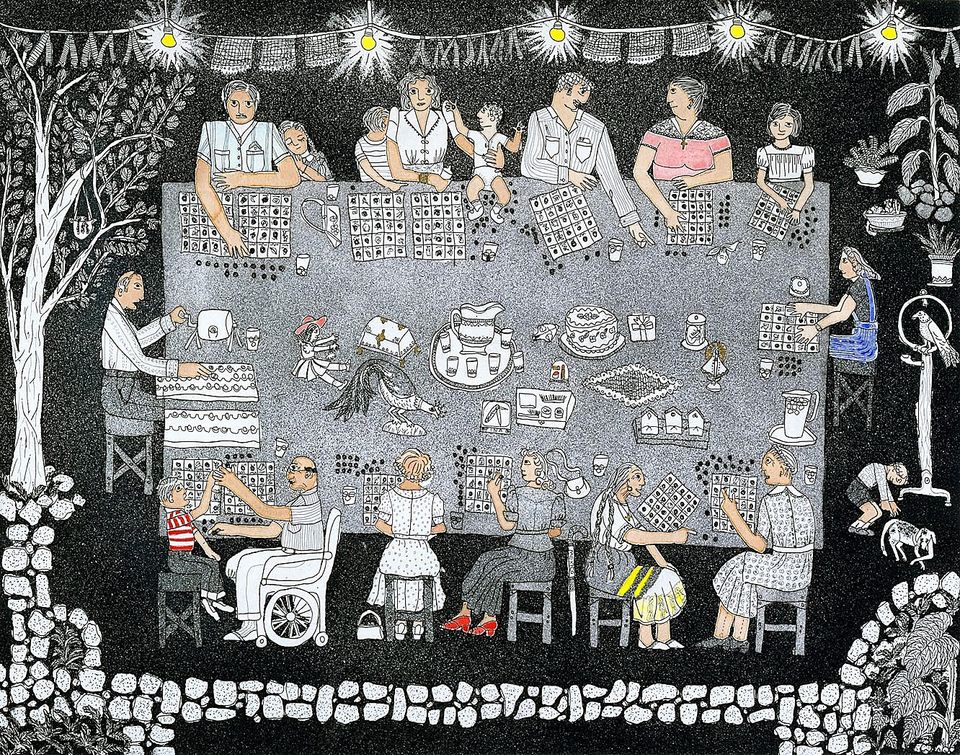Teacher Guides
Teacher Guides are free, downloadable PDFs.
Arte y Cultura Latino: La tradición artística del Sudoeste / Latino Art & Culture: Artistic Tradition in the Southwest
¿Cuáles son las influencias históricas en el desarrollo de las tradiciones artísticas del sudoeste?
Esta porción del módulo de Arte y Cultura Latino explica cómo la tradición de los santos reflejo de los valores culturales del pasado y presente.
Tema y grado primarios: Artes visuales 5–12
Tema y grado secundarios: Historia –12 de los Estados Unidos.
Componentes: contexto histórico, imágenes y descripciones de la imagen, mapa de pueblos y ciudades en el Sudoeste, biografías del artistas, sugerencias de las actividades de los estudiantes.
Estándares: Artes visuals K–12.6 que hacen conexiones entre los artes visuales y otro disciplinas; K–12.4 que entiende los artes visuales en lo referente a historia y las culturas; K–12.3 que elige y que evalúa una gama de tema.
La historia de los Estados Unidos Era 1 reunión de tres mundos (principios a 1620); Era 2 Colonización y establecimiento (1585-1763).
What are the historical influences on the development of artistic traditions in the Southwest US?
This portion of the Latino Art & Culture module explains how the santo tradition reflects past and present cultural values.
Primary Subject and Grade: Visual Arts 5–12
Secondary Subject and Grade: U.S. History 5–12.
Components: Historical Context, Images and Descriptions, Map of Pueblos and Towns in the Southwest, Artist Bios, Student Activity Suggestions.
Standards: Visual Arts K–12.6 Making Connections Between Visual Arts and Other Disciplines; K–12.4 Understanding the Visual Arts in Relation to History and Cultures; K–12.3 Choosing and Evaluating a Range of Subject Matter.
U.S. History Era 1 Three Worlds Meet (Beginnings to 1620); Era 2 Colonization and Settlement (1585-1763).
Arte y Cultura Latino: El cruce de culturas y la mezcla de influencias / Latino Art & Culture: Mixing Cultures and Blending Influences
¿Cuáles son las fuentes históricas, sociales, y culturales que informan al trabajo de las artistas latinoamericano?
Esta porción del módulo de Arte y Cultura Latino describe raíces culturales del Latino de una mezcla rica de fuentes europeas, indígenas, y africanas.
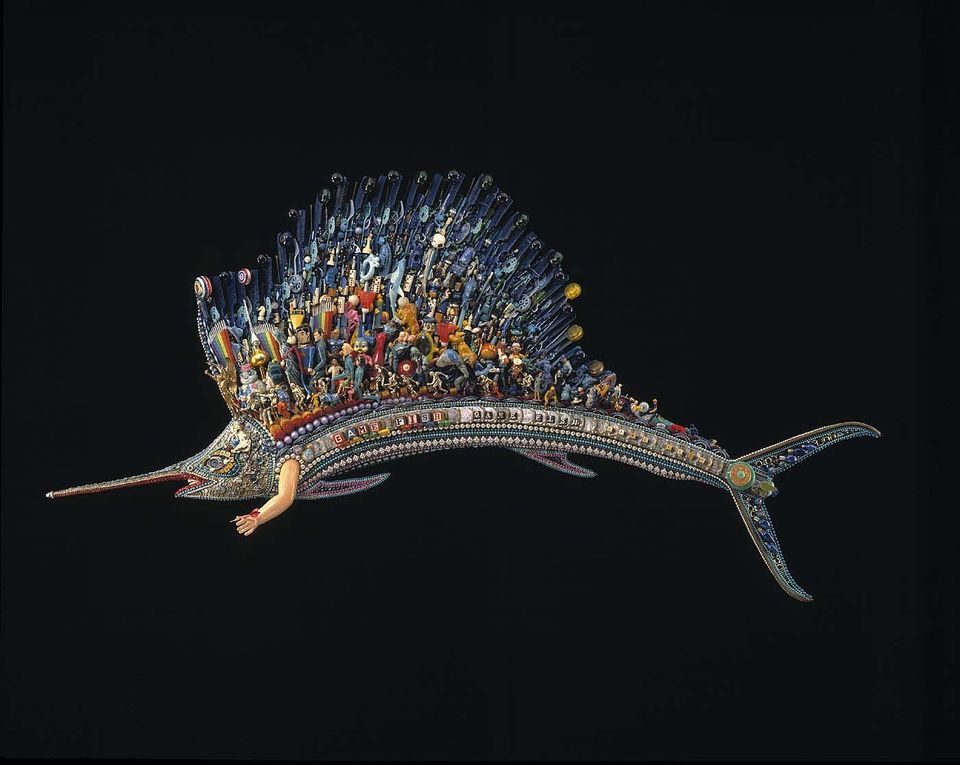
Larry Fuente, Game Fish, 1988, fiberglass, black auto-body type epoxy resin, polyurethane resin, plywood, plastic found objects including beads, buttons, poker chips, badminton birdies, ping pong balls, rhinestones, coins, dice, plastic figurines, combs, miniature pinball games
Tema y grado primarios: Artes visuales 5–12
Tema y grado secundarios: Historia –12 de los Estados Unidos.
Componentes: contexto histórico, imágenes y descripciones de la imagen, biografías del artistas, sugerencias de las actividades de los estudiantes.
Estándares: Artes visuals K–12.6 que hacen conexiones entre los artes visuales y otro disciplinas; K–12.4 que entiende los artes visuales en lo referente a historia y las culturas; K–12.3 que elige y que evalúa una gama de tema.
La historia de los Estados Unidos Era 1 reunión de tres mundos (principios a 1620); Era 2 Colonización y establecimiento (1585-1763).
What are the historical, social, and cultural sources that inform the work of Latino artists?
This portion of the Latino Art & Culture module describes Latino cultural roots from a rich mixture of European, indigenous, and African sources.

Larry Fuente, Game Fish, 1988, fiberglass, black auto-body type epoxy resin, polyurethane resin, plywood, plastic found objects including beads, buttons, poker chips, badminton birdies, ping pong balls, rhinestones, coins, dice, plastic figurines, combs, miniature pinball games
Primary Subject and Grade: Visual Arts 5–12
Secondary Subject and Grade: U.S. History 5–12.
Components: Historical Context, Images and Descriptions, Artist Bios, Student Activity Suggestions.
Standards: Visual Arts K–12.6 Making Connections Between Visual Arts and Other Disciplines; K–12.4 Understanding the Visual Arts in Relation to History and Cultures; K–12.3 Choosing and Evaluating a Range of Subject Matter.
U.S. History Era 1 Three Worlds Meet (Beginnings to 1620); Era 2 Colonization and Settlement (1585-1763).
Arte y Cultura Latino: La nueva vida en los Estados Unidos / Latino Art & Culture: Making a New Life in the United States
¿Cuáles son los factores históricos que influyen sobre las modalidades de migración e inmigracón a los Estados Unidos de la población de origen latinoamericano?
Esta porción del módulo de Arte y Cultura Latino describe cómo se han adaptado los latinos a su Nuevo entorno, desde la perspective de los artistas mexicano-americanos, puertorriqueños y cubano-americanos.
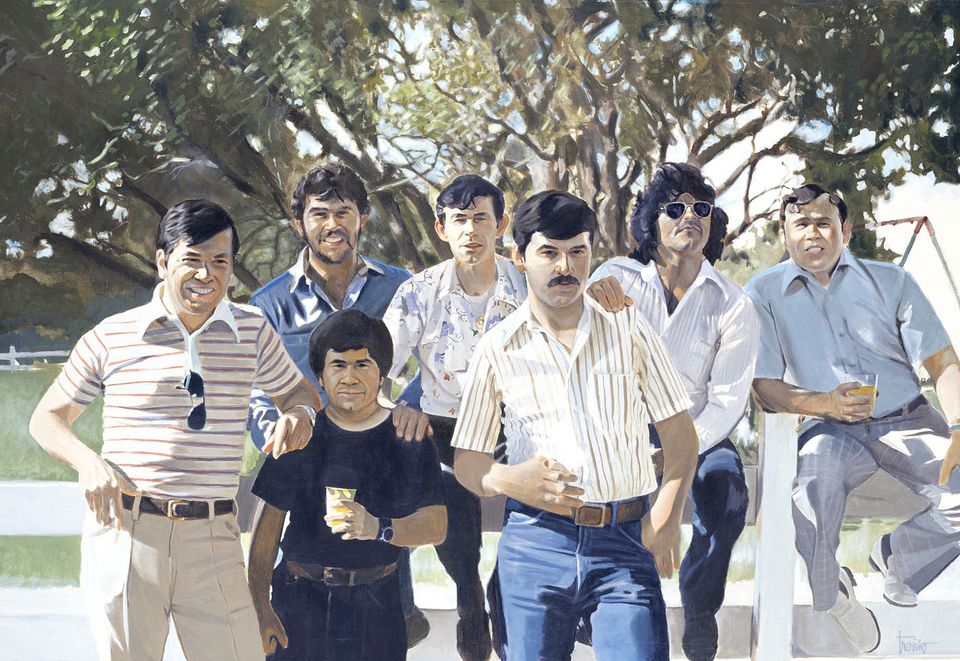
Jesse Treviño, Mis Hermanos, 1976, acrylic on canvas
Tema y grado primarios: Artes visuales 5–12
Tema y grado secundarios: Historia –12 de los Estados Unidos.
Componentes: contexto histórico, imágenes y descripciones de la imagen, biografías del artistas, sugerencias de las actividades de los estudiantes.
Estándares: Artes visuals K–12.6 que hacen conexiones entre los artes visuales y otro disciplinas; K–12.4 que entiende los artes visuales en lo referente a historia y las culturas; K–12.3 que elige y que evalúa una gama de tema.
La historia de los Estados Unidos Era 8 La Gran Depresión y la Segunda Guerra Mundial (1929-1945) Era 9 Estados Unidos de la posguerra (1945 a las comienzos de los años 70) Era 10 Estados Unidos contemporáneos (1968 al presente).
How can artwork teach us about Latino culture in the United States?
This portion of the Latino Art and Culture module takes a close look at the art and culture of Puerto Rican-Americans, Mexican-Americans, and Cuban Americans.

Jesse Treviño, Mis Hermanos, 1976, acrylic on canvas
Primary Subject and Grade: U.S. History 5–12; Visual Arts 5–12
Components: Artist Bios, Detailed Image Descriptions, Student Activity Suggestions
Standards: U.S. History Era 8 The Great Depression and World War II; Era 9 Post-War United States (1945–early 1970s); Era 10 Contemporary United States (1968–present).
Visual Arts K–12.6 Making Connections Between Visual Arts and Other Disciplines; K–12.4 Understanding the Visual Arts in Relation to History and Cultures; K–12.3 Choosing and Evaluating a Range of Subject Matter.
Arte y Cultura Latino: La expresión de cuestiones de interés social / Latino Art & Culture: Expressions of Social Concern
¿Cuáles son las fuentes históricas y culturales que informan al contenido social de la obra de los artistas latinos?
Esta porción del módulo de Arte y Cultura Latino examina el movimiento chicano en los Estados Unidos.
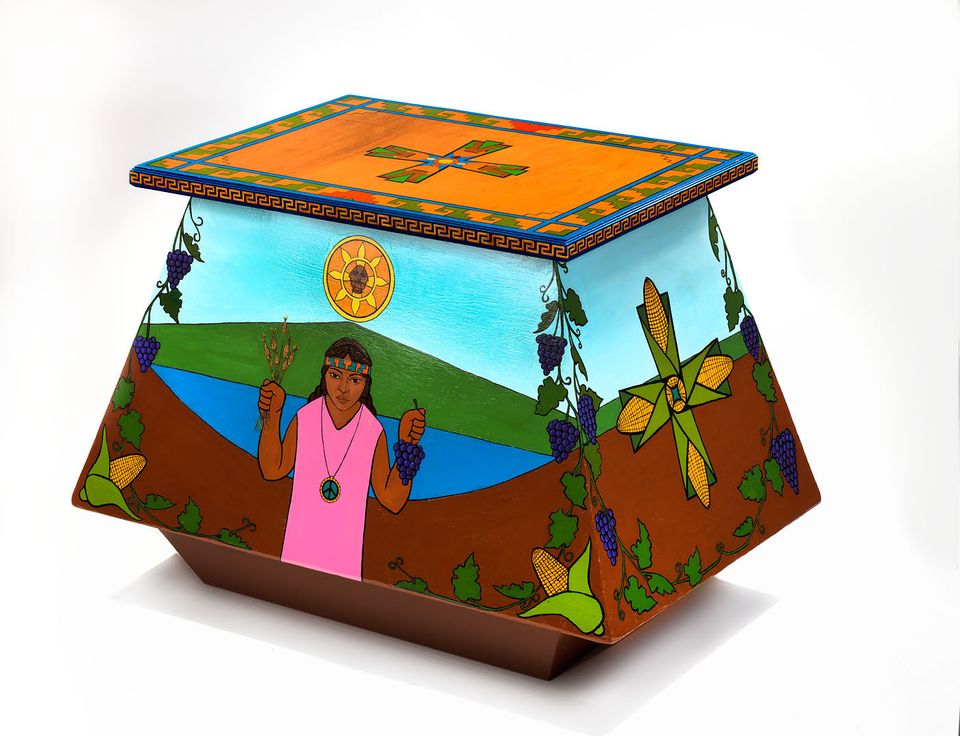
Emanuel Martinez, Farm Workers' Altar, 1967, acrylic on mahogany and plywood
Tema y grado primarios: Artes visuales 5–12
Tema y grado secundarios: Historia –12 de los Estados Unidos.
Componentes: contexto histórico, imágenes y descripciones de la imagen, biografías del artistas, sugerencias de las actividades de los estudiantes.
Estándares: Artes visuals K–12.6 que hacen conexiones entre los artes visuales y otro disciplinas; K–12.4 que entiende los artes visuales en lo referente a historia y las culturas; K–12.3 que elige y que evalúa una gama de tema.
La historia de los Estados Unidos Era 9 Estados Unidos de la posguerra (1945 a las comienzos de los años 70).
What are the historical and cultural sources that inform social content in Latino artworks?
This portion of the Latino Art & Culture module examines the Chicano movement in the US.

Emanuel Martinez, Farm Workers' Altar, 1967, acrylic on mahogany and plywood
Primary Subject and Grade: Visual Arts 5–12
Secondary Subject and Grade: U.S. History 5–12.
Components: Historical Context, Images and Descriptions, Artist Bios, Student Activity Suggestions.
Standards: Visual Arts K–12.6 Making Connections Between Visual Arts and Other Disciplines; K–12.4 Understanding the Visual Arts in Relation to History and Cultures; K–12.3 Choosing and Evaluating a Range of Subject Matter.
U.S. History Era 9 Postwar United States (1945 to early 1970s).
Public Sculpture: Vaquero
What was the Mexican contribution to the cowboy heritage?
This lesson explains stereotypes and the difference between real and mythical cowboys.
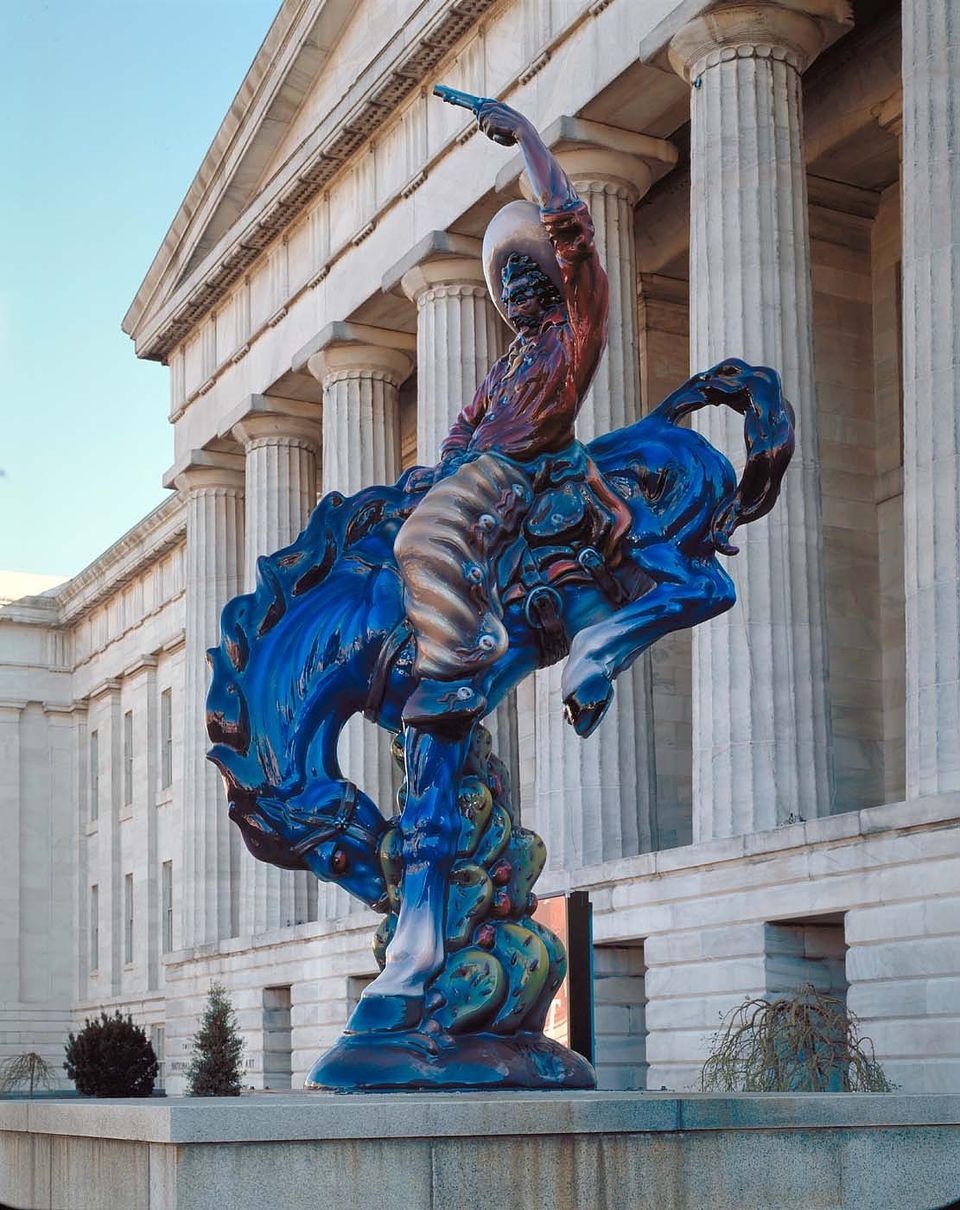
Luis Jiménez, Vaquero, modeled 1980/cast 1990, acrylic urethane, fiberglass, steel armature
Primary Subject and Grade: Visual Arts 5–12, U.S. History 5–12.
Components: Historical Context, Images and Descriptions, Student Activity Suggestions, Bibliography, Glossary, Artist Biography.
Standards: Visual Arts K–12.6 Making Connections Between Visual Arts and Other Disciplines; K–12.4 Understanding the Visual Arts in Relation to History and Cultures; K–12.3 Choosing and Evaluating a Range of Subject Matter.
U.S. History Era 4 Expansion and Reform (1800–1861).
Videos
Through the Barbed Wire: Domingo Ulloa’s Braceros
Domingo Ulloa's Braceros depicts of a group of guest workers brought to the United States from Mexico to fill in agricultural labor shortages caused by World War II and encourages viewers to think about the conditions in which the men lived and worked.
Art in Times of Crisis: Luis Cruz Azaceta’s Shifting States: Iraq
SAAM Curator E. Carmen Ramos explains how artist Luis Cruz Azaceta responded to the series of uprisings across the Middle East in the early 2010s collectively referred to as the Arab Spring.
Our America: The Latino Presence in American Art
Our America: The Latino Presence in American Art presents the rich and varied contributions of Latino artists in the United States since the mid-twentieth century, when the concept of a collective Latino identity began to emerge. The exhibition is drawn entirely from the Smithsonian American Art Museum’s pioneering collection of Latino art. It explores how Latino artists shaped the artistic movements of their day and recalibrated key themes in American art and culture.
In this special seven-episode series, E. Carmen Ramos, SAAM Curator of Latinx Art, highlights key works from the exhibition Our America: The Latino Presence in American Art. Featured works include the following:
Humanscape 62 by Melesio Casas
Blanco y Verde by Carmen Herrera
Nocturnal (Horizon Line) by Teresita Fernández
Granite Weaving by Jesús Moroles
Death of Rubén Salazar by Frank Romero
Maria's Great Expedition by Christina Fernandez
Two untitledphotographs by Sophie Rivera
Hiram Maristany on Photographing His East Harlem Community
Hiram Maristany’s street photographs of New York City's El Barrio in the 1960s and early 1970s are an ode to his beloved neighborhood.
Hiram Maristany’s street photographs of New York City's El Barrio in the 1960s and early 1970s are an ode to his beloved neighborhood.
Perla de Leon on South Bronx Spirit
Perla de Leon’s poignant photographs of the South Bronx in New York place into sharp relief the physical devastation of the neighborhood and the lives of the people who called it home. The artist discusses her 1980 series "South Bronx Spirit," which capture the life, laughter, and resiliency of the community in which de Leon was teaching at the time.
Photographer Perla de Leon discusses her 1980 series South Bronx Spirit, which captures the life, laughter, and resiliency of the New York City community in which she was teaching at the time.
Ruben Ochoa on What if Walls Created Spaces?
Ruben Ochoa deliberately tampers with the appearance of the I-10, a freeway that runs through East Los Angeles. He created a lenticular print that interlaces two different views of a freeway wall. As viewers walk past his photograph, the wall partially disappears, opening up a portal into an imaginary verdant landscape.
Ruben Ochoa’s lenticular print alters the appearance of the I-10 freeway that runs through East Los Angeles: As viewers walk past his photograph, the wall partially disappears, opening up a portal into an imaginary verdant landscape.
Camilo José Vergara on 65 East 125th Street, Harlem
Camilo José Vergara captured, through photography, over 40 years of changes in the urban landscape of 65 East 125th Street in Harlem. Through these photographs, he tells the story of change, growth, and life in Harlem.
Through a series of photographs taken at the same location over a span of forty years, Camilo José Vergara tells the story of change, growth, and life on 65 East 125th Street in Harlem.
Abelardo Morell on Camera Obscura Image of Manhattan View Looking West in Empty Room
Photographer Abe Morell discusses his relationship to New York City, his use of camera obscura, and his work being part of SAAM’s collection.
Photographer Abe Morell discusses his relationship to New York City, his use of camera obscura, and his work being part of SAAM’s collection.
Manuel Acevedo on Altered Sites #7
Manuel Acevedo reimagines the streets of his hometown of Newark, New Jersey, a city shaped by periods of unrest and urban renewal initiatives that tore down existing housing to erect massive housing projects.
By drawing on top of his photograph, Manuel Acevedo reimagines the streets of his hometown of Newark, New Jersey, a city shaped by periods of unrest and urban renewal initiatives that tore down existing housing to erect massive housing projects.
Lalo Alcaraz’s I Stand with Emma
Artist Lalo Alcaraz created the striking digital portrait I Stand with Emma of Emma González after watching the high school senior advocate for stronger gun control in an impassioned speech days after surviving the shooting at Marjory Stoneman Douglas High School in Parkland, Florida.
Join Claudia Zapata, curatorial assistant for Latinx art at the Smithsonian American Art Museum for a closer look. Learn how <em>I Stand with Emma,</em> an artwork that was created and distributed within the digital sphere, honors the traditions of Chicanx artists while also embracing new digital landscapes for printmaking and celebrating a new generation of activists, "guiding us towards a better tomorrow."
This video is part of the Smithsonian American Art Museum's ongoing series American Art Moments. Join a SAAM expert and go beyond the artwork label to discover the untold stories and rich connections represented in some of the museum's most iconic artworks.
Image: "L.A. Stands With Emma, Too"
February 19, 2018
Photograph by Robb Wilson
Robb Wilson Flickr
CC BY-SA 2.0
Artist Lalo Alcaraz created the striking digital portrait I Stand with Emma of Emma González after watching the high school senior advocate for stronger gun control in an impassioned speech days after surviving the shooting at Marjory Stoneman Douglas High School in Parkland, Florida. Learn how I Stand with Emma, an artwork that was created and distributed within the digital sphere, honors the traditions of Chicanx artists while also embracing new digital landscapes for printmaking.
Rupert García on His Posters for Social Change
Artist Rupert García discusses the rise of the Chicano movement and the political icons who became the inspiration behind his posters. By highlighting individuals engaged in the fight for social justice, García challenges who gets to be represented and examines the relationship he creates between aesthetics and politics. García’s prints were featured in the exhibition ¡Printing the Revolution! The Rise and Impact of Chicano Graphics, 1965 to Now.
Artist Rupert García discusses the rise of the Chicano movement and the political icons who became the inspiration behind his posters.
More Resources
Latinx Art Teaching Posters: Chicano Graphics
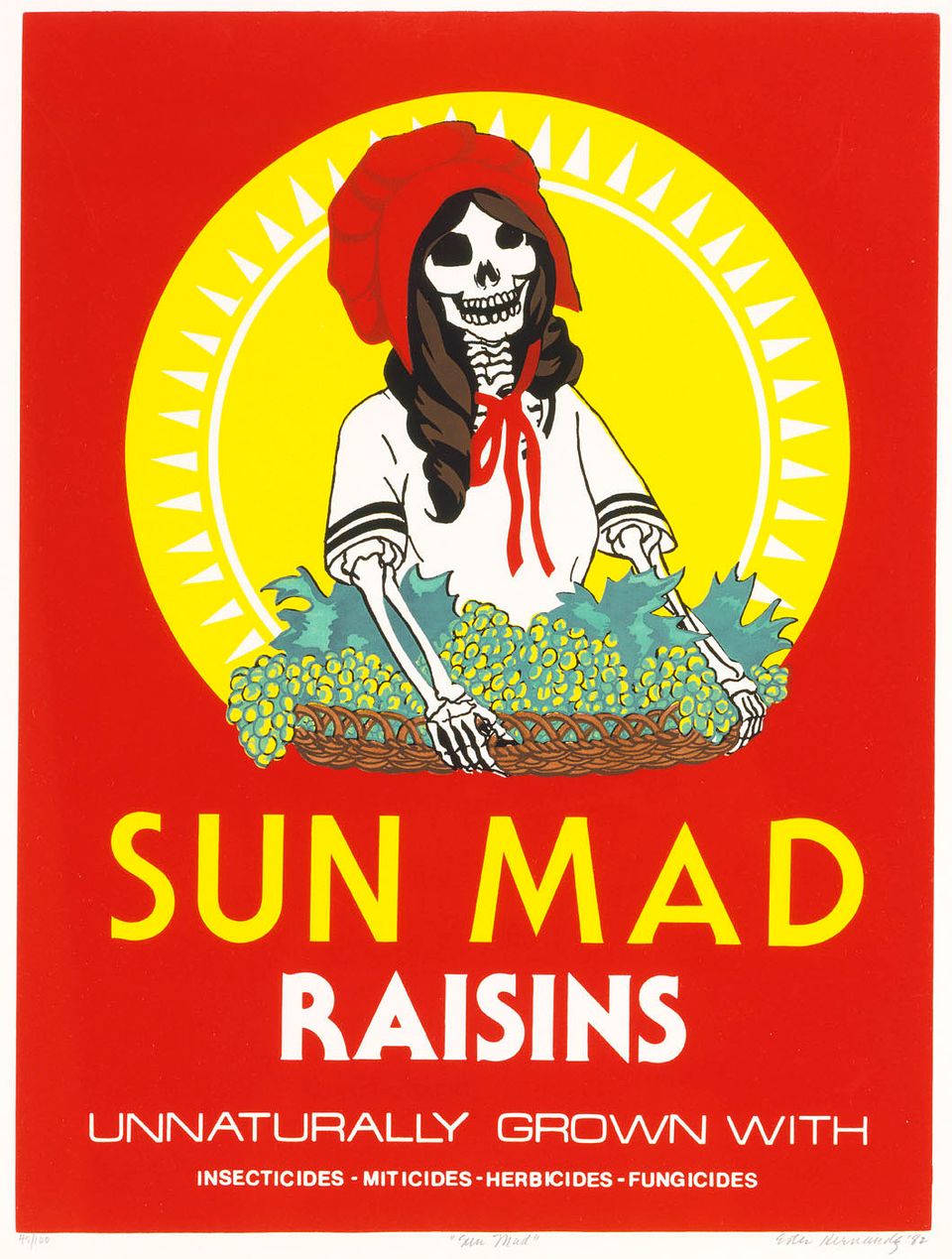
Ester Hernández, Sun Mad, 1982, screenprint on paper, Smithsonian American Art Museum, Gift of Tomás Ybarra-Frausto, 1995.50.32, © 1982, Ester Hernández
Request a free set of bilingual (English and Spanish) teaching posters for your classroom.
Changemakers Portraits

Barbara Carrasco, Dolores, 1999, screenprint on paper, Smithsonian American Art Museum, Museum purchase through the Frank K. Ribelin Endowment, 2020.22.7, © 1999, Barbara Carrasco
These portraits reveal how Chicanx artists and their collaborators highlight individuals, past and present, whose actions have shaped the course of history. This resource was created in conjunction with the exhibition ¡Printing the Revolution! The Rise and Impact of Chicano Graphics, 1965 to Now.
¡Printing the Revolution! Visual Connections
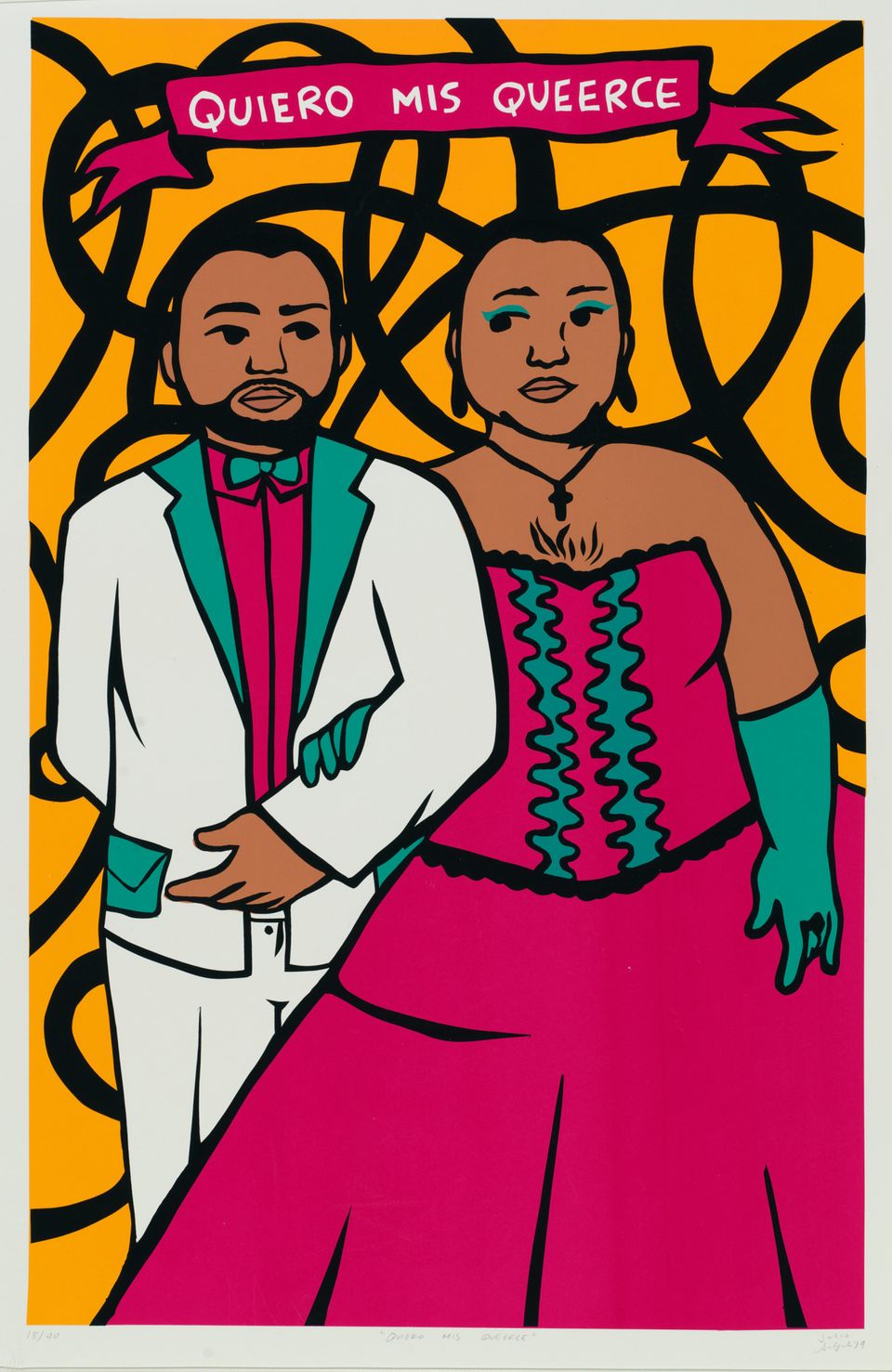
Julio Salgado, Quiero Mis Queerce, 2014, screenprint on paper, Smithsonian American Art Museum, Museum purchase through the Lichtenberg Family Foundation, 2020.37.6, © 2020, Julio Salgado
Look at works from SAAM’s exhibition ¡Printing the Revolution! alongside related images and explore these connections more deeply with open-ended question prompts.
Sí se Puede!
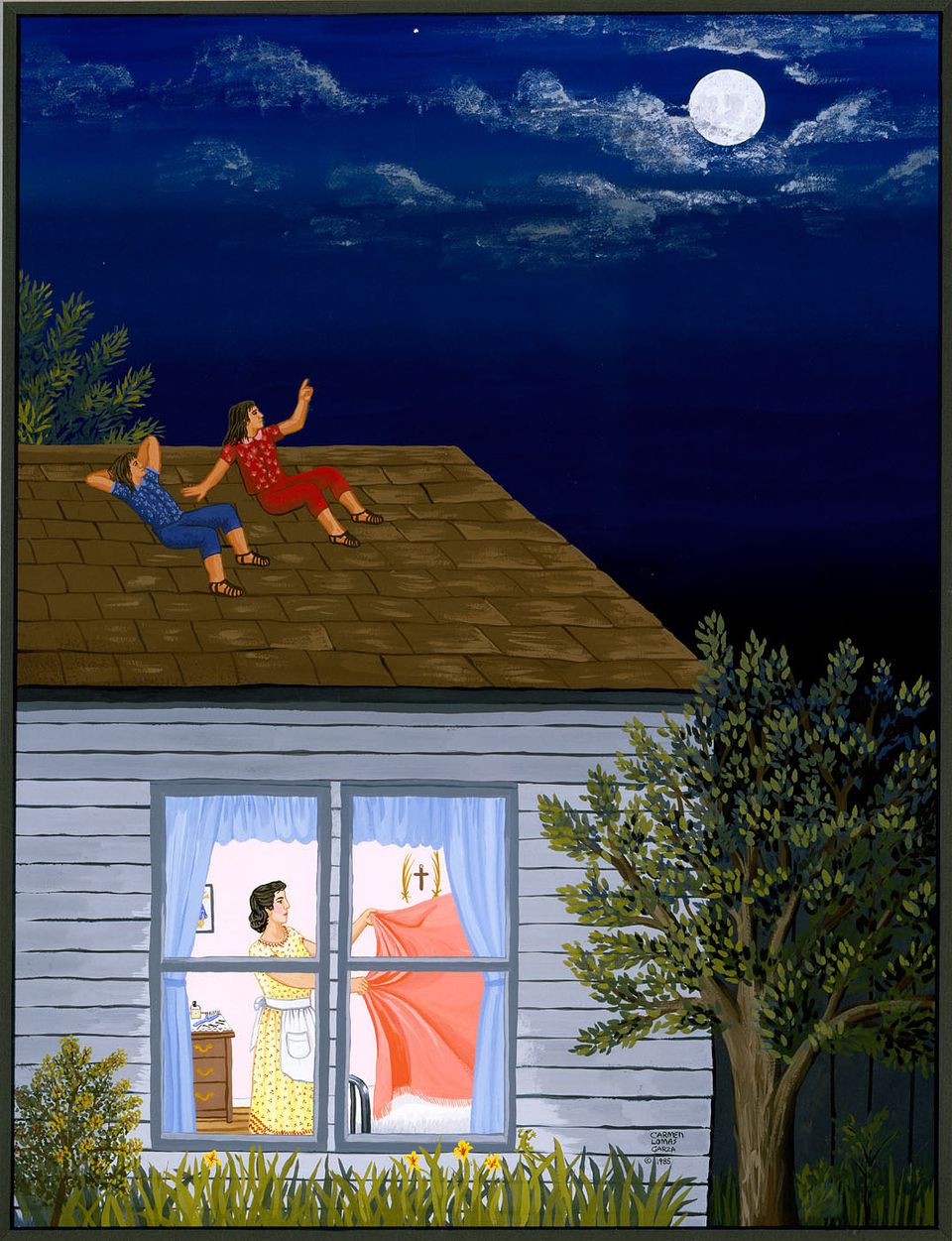
Carmen Lomas Garza, Camas para Sueños, 1985, gouache on paper, Smithsonian American Art Museum, Museum purchase through the Smithsonian Latino Initiatives Pool and the Smithsonian Institution Collections Acquisition Program, 1995.94, © 1985, Carmen Lomas Garza
Look closely at Farm Workers’ Altar (1967) by Emanuel Martinez and Camas para Sueños (1985) by Carmen Lomas Garza within the context of the Mexican American Civil Rights Movement and its legacy on the education resource The American Experience in the Classroom.
Perla de Leon’s poignant photographs of the South Bronx in New York place into sharp relief the physical devastation of the neighborhood and the lives of the people who called it home. The artist discusses her 1980 series "South Bronx Spirit," which capture the life, laughter, and resiliency of the community in which de Leon was teaching at the time.
Photographer Perla de Leon discusses her 1980 series South Bronx Spirit, which captures the life, laughter, and resiliency of the New York City community in which she was teaching at the time.
Hiram Maristany’s street photographs of New York City's El Barrio in the 1960s and early 1970s are an ode to his beloved neighborhood.
Hiram Maristany’s street photographs of New York City's El Barrio in the 1960s and early 1970s are an ode to his beloved neighborhood.














